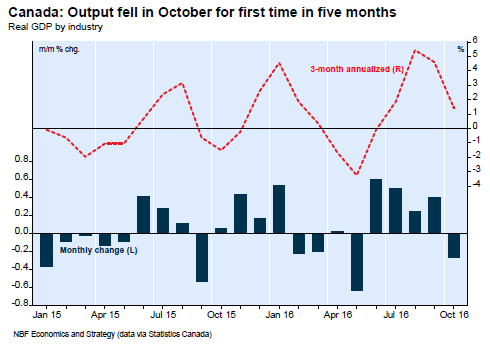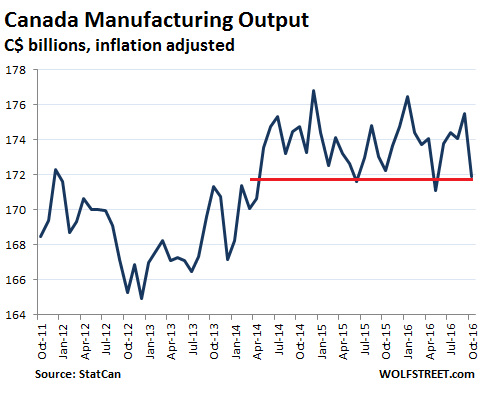Many countries, including the US, report GDP on a quarterly basis. Canada reports on a monthly basis. So today Statistics Canada reported GDP for October. What’s disconcerting isn’t so much that GDP fell 0.3% on a monthly basis – these things happen – though it disappointed economists along the way…
The “results were surprisingly bad,” wrote Krishen Rangasamy, senior economist at Economics and Strategy, National Bank of Canada.
“The GDP report is an ugly snowball of reality to the face of the economy to end the year after a nice run earlier in the fall,” said Douglas Porter, chief economist BMO .
But what was disconcerting was just how much the goods producing sectors are getting hammered across the board.
This chart by NBF Economics and Strategy shows the decline in October (blue bars, left scale), and it also shows that this type of monthly decline, during our mediocre economic era, is not rare. The red line (right scale) shows the annualized rate for the last three months, which is still positive, but careening lower:

Output of the overall goods producing industries caved 1.3% from September. It was broad-based, with manufacturing, mining, quarrying, and oil & gas extraction, construction, utilities, agriculture, and forestry all declining. It more than wiped out the gains of the goods producing sectors in September.
Manufacturing, which contributes about 10% to GDP, has taken a big beating, despite the loonie that the Bank of Canada has successfully devalued over the past few years to make exports more competitive, particularly in the US. But manufacturing output fell 2% on a monthly basis, the largest monthly decline since December 2013. It has gone nowhere since February 2014 (red line):

Both durable and non-durable manufacturing fell. StatCan:
…click on the above link to read the rest of the article…
















